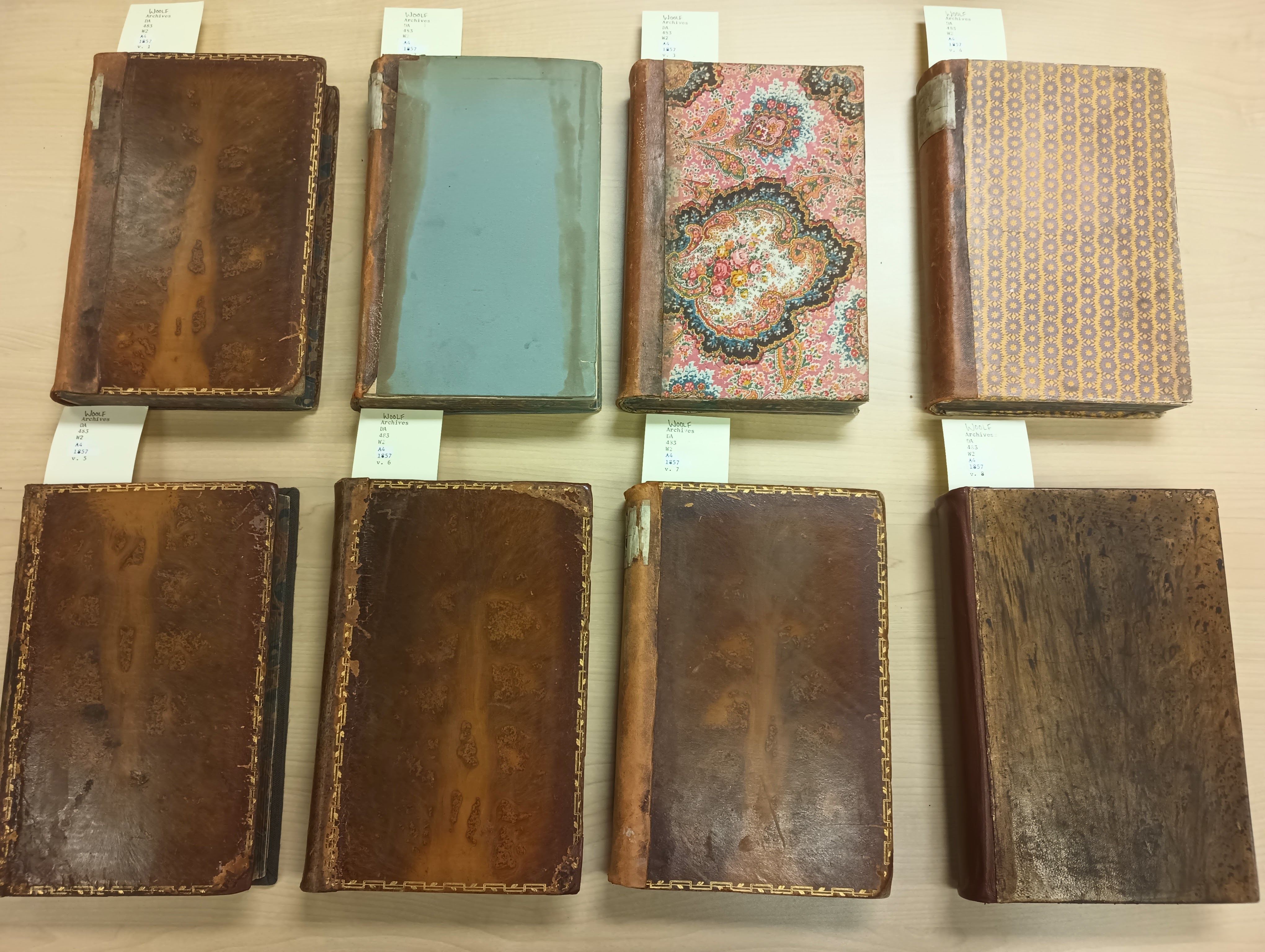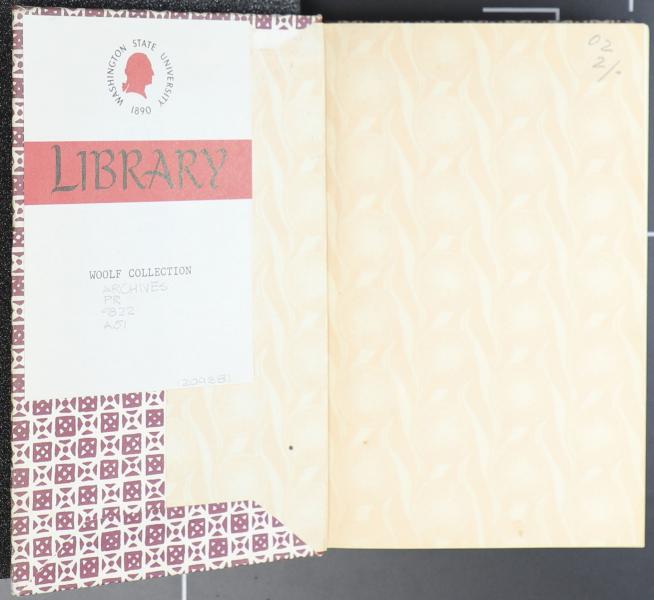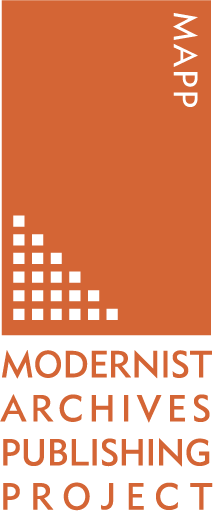Last October, I visited the beautiful Washington State University Pullman and spent a week immersed in the Library of Leonard and Virginia Woolf. Part of my role as a research assistant with MAPP is to collaborate and develop relationships with partner institutions, including Pullman. The team at the library’s Manuscripts, Archives, & Special Collections (MASC) generously offered their time and expertise during my trip. Upon arrival, Trevor Bond, Associate Dean Libraries, whisked me off on a tour of the collection—nearly 6000 items, the bulk of which consists of the Woolfs’ personal library. Among the collection are volumes Virginia inherited from her father, books she and Leonard bought or were given by friends and acquaintances, and first editions of Hogarth Press publications. There is even a collection of ephemera (including flowers) that were discovered tucked inside various volumes.
On my first day, Trevor provided me with a cart loaded with interesting examples to get started with, including the complete set of Peter Cunningham’s edited Letters of Horace Walpole (1857-59) which demonstrate a variety of Virginia’s bindings. These volumes, among many others in the collection, were passed down to Virginia from her father. Five of the Walpole volumes are bound with leather, two with paper (one light blue, the other featuring columns of pale purple circles on a yellow background), and one volume with a bright, predominantly pink cloth cover.

Eight volumes of The Letters of Horace Walpole, Earl of Orford. Ed. by Peter Cunningham. London: Bentley, 1857-59, arranged in two rows.
Another example of Virginia’s bound volumes that caught my interest was Jacques-Émile Blanche’s Cahiers D’un Artiste (1920), given to Virginia in 1927 by the author. Blanche painted Virginia’s portrait in 1927 and the inscription inside the cover of Cahiers indicates that he presented the book to her in the same year. Bound with a simple beige cloth without a book board, the item demonstrates Virginia’s creativity and experimentation with different types of binding. The uncut pages of the book reveal, however, that despite investing some creative effort into it, Virginia never actually read the text. As Diane Gillespie writes in the Introduction to the Woolf Library catalogue, “[g]ift books and review copies were, no doubt, sometimes unwelcome or uninteresting. Indeed, now and then one finds a volume with uncut pages.”



Top: cloth cover of Cahiers held up to show the lack of book board, with title page visible beneath. Center: half-title page of Cahiers with inscription by Blanche to Virginia Woolf. Bottom: uncut pages of Cahiers.
One of my goals during the trip was to identify interesting examples to discuss during my presentation at the MAPP panel at this year’s MSA conference. Considering the 1922 theme of the conference, I focused particularly on 1922 Hogarth Press publications as well as volumes in the Woolfs’ private collection that were published in 1922. Among these were Hilaire Belloc’s The Jews, containing handwritten notes by Leonard, and a rather battered copy of Marcel Proust’s Sodome Et Gomorrhe II featuring a bright yellow paper binding by Virginia.



Left: inside front cover of Proust’s Sodome Et Gomorrhe II, disconnected from the body of the book which sits to the right. Center: exposed spine of Sodome with small section of Virginia Woolf’s yellow binding. The original binding with publication location and date is exposed at bottom. Right: endpaper of Belloc’s The Jews with notes in pencil by Leonard Woolf.
During the week I also met with Julia King, Rare Books Cataloger, who undertook the task of cataloguing the vast collection with Laila Miletic-Vejzovic in 2003. Julia answered questions and discussed the history of the collection with me. Julia also offered insight into an exciting volume in the collection, MASC’s first edition copy of Jacob’s Room (1922). MASC houses two first editions, but the second appears to be a pre-publication copy. It features pencil markups and numerous pages with corners cut out. There is even evidence of damage where something was pasted down and later removed.
Currently, the MAPP website houses letters and ephemera related to Jacob’s Room as well as a complete scan of a first edition copy in PDF format. An additional complete scan of the pre-publication copy held at Pullman’s MASC could prove a useful resource for further research into the publication of the novel.



Left: pages from Jacob’s Room with top right corners cut out. Center: title page of Jacob’s Room crossed out with “X” in pencil. Right: bottom left page of Jacob’s Room with small hole where something appears to have been removed.
My first term working with MAPP consisted of uploading images of materials scanned by Kathryn Manis—PhD Candidate in the English Department at WSU and former graduate employee of MASC—from Pullman’s Woolf collection to the new MAPP website. I spent hours every week adding metadata to the images, an integral part of MAPP’s feminist praxis towards attribution and recovery of marginalized figures in publishing history. Actually having the opportunity to travel to Pullman and see the Woolf library collection in person put into perspective the scale of the MAPP project and the challenges of selection criteria for a critical digital archive. It also underscored the importance of partner institutions like Pullman who make MAPP a valuable resource.
I am thankful for the care and assistance provided by Trevor Bond, Julia King, Mark O’English, and everyone at MASC during my week in Pullman. I am also grateful to Dr. Diane Gillespie who graciously discussed her Woolf scholarship and love for archives with me over a cup of coffee.
My next project for MAPP will involve a trip to another partner institution, the New York Public Library, to explore materials in the Berg Collection. I look forward to sharing insights from that trip later this Spring!




